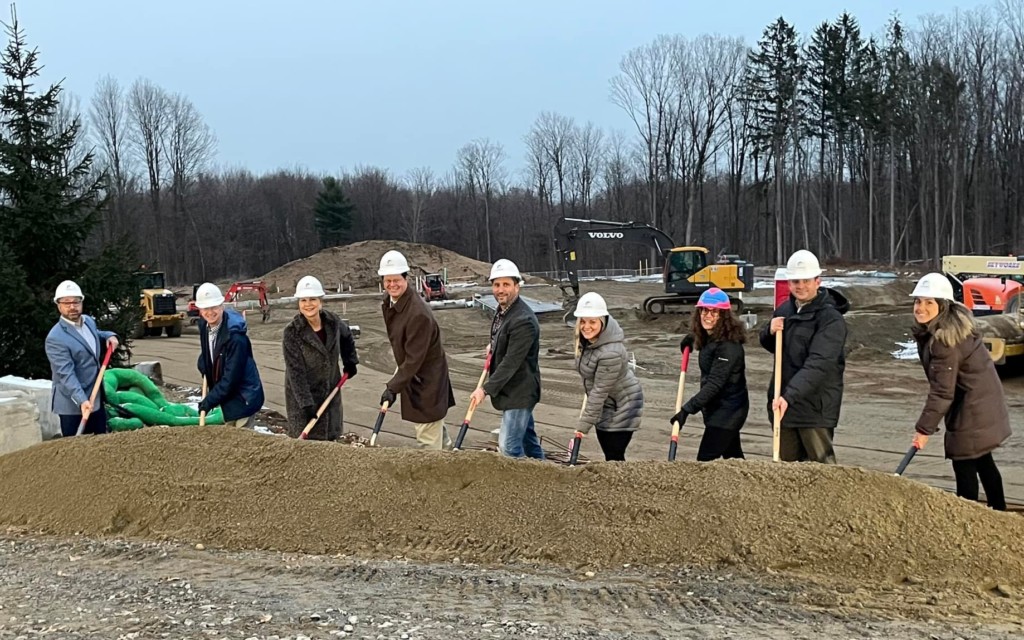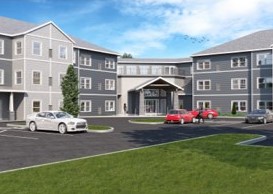This article, by Kathleen Moore, discussing RISE Housing and Support Services affording housing project, Dominic Hollow, appeared in the Albany Times-Union on Dec. 1, 2021.

BALLSTON – As property values climb so high that some young teachers in Saratoga County can’t cover their rent, a new affordable housing development is under way to help.
The 60-unit development at 11 Dominick Drive, dubbed Dominick Hollow, is nowhere near enough to meet the need. But it’s a start, said RISE Healthy Housing and Support Services Executive Director Sybil Newell.
“We’re making a little dent but we’re starting somewhere,” she said before the ceremonial groundbreaking at the site Tuesday. Construction work there has already begun, and the units are expected to be finished in the spring. She worked tirelessly for years to bring together the private and public funds needed to make the $21 million project happen, and now she is working on another one in Corinth.
“I think there’s an endless need for affordable housing out there,” she said. “For supportive housing, there is always a wait list. In my entire time working in this field – 20 years – there is a constant wait list for people who need supportive housing.”
Half the units will be set aside for those who need support, generally due to substance abuse or mental illness.
“People who just need a little bit of extra help to maintain in the community on their own,” she said. “We are just proposing to give them a beautiful, affordable, safe place to live and someone to look in on them from time to time so we can make sure they are following through with taking care of themselves, paying their bills, getting to their medical appointments. There’s a misconception that it costs too much money.”
It actually saves money because people don’t end up needing emergency services, she said.
 But affordable housing is needed by many people who don’t need support. They just need rent to be low enough to live.
But affordable housing is needed by many people who don’t need support. They just need rent to be low enough to live.
To qualify for the affordable housing, renters must earn less than 60 percent of the area median income.
“That’s somewhere in the $40,000 range,” she said. “That’s what some of our teachers are making.”
Low-wage support jobs, from nursing assistants to fast food workers, also tend to pay less than $40,000.
That’s why Saratoga County Chamber of Commerce President Todd Shimkus calls the units “workforce housing.”
“In this time when we have such a labor shortage, it’s a long-term commitment to attract people,” he said. “With housing prices going up, we’ve got to have more projects like this.”
Many people, including teachers, live elsewhere and drive long distances to work because they can’t afford Saratoga County rent, said Darren Scott, upstate east director of development for the state Homes and Community Renewal agency.
“We must ensure people who work here can continue to live here,” he said.
But there aren’t many places where affordable housing can be built, Shimkus said. Many people who qualify for affordable housing don’t have a car. That means they must live near a bus route.
“That limits it, because our public transportation is so limited,” he said. “The demand outpaces the supply, but it’s not just supply that’s the problem, it’s that we don’t have a more robust public transportation.”
Dominick Hollow is on the bus route, and many speakers at Tuesday’s groundbreaking cited that as the reason why the site was ideal for affordable housing.
“It’s one of the only bus lines in this area,” Newell said. “They’re going to have access to public transportation, which is very, very rare in this area.”

